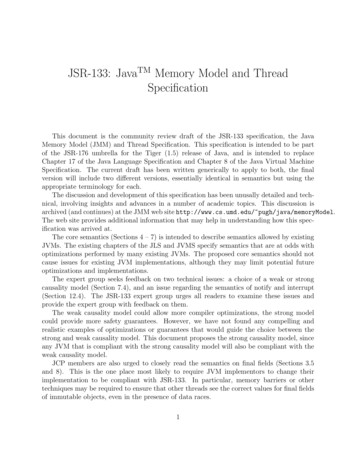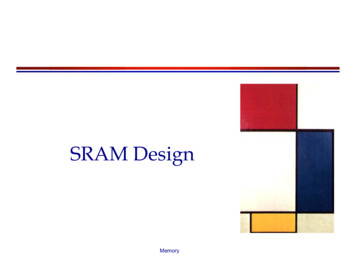
Transcription
JSR-133: JavaTM Memory Model and ThreadSpecificationThis document is the community review draft of the JSR-133 specification, the JavaMemory Model (JMM) and Thread Specification. This specification is intended to be partof the JSR-176 umbrella for the Tiger (1.5) release of Java, and is intended to replaceChapter 17 of the Java Language Specification and Chapter 8 of the Java Virtual MachineSpecification. The current draft has been written generically to apply to both, the finalversion will include two different versions, essentially identical in semantics but using theappropriate terminology for each.The discussion and development of this specification has been unusally detailed and technical, involving insights and advances in a number of academic topics. This discussion isarchived (and continues) at the JMM web site http://www.cs.umd.edu/ pugh/java/memoryModel.The web site provides additional information that may help in understanding how this specification was arrived at.The core semantics (Sections 4 – 7) is intended to describe semantics allowed by existingJVMs. The existing chapters of the JLS and JVMS specify semantics that are at odds withoptimizations performed by many existing JVMs. The proposed core semantics should notcause issues for existing JVM implementations, although they may limit potential futureoptimizations and implementations.The expert group seeks feedback on two technical issues: a choice of a weak or strongcausality model (Section 7.4), and an issue regarding the semantics of notify and interrupt(Section 12.4). The JSR-133 expert group urges all readers to examine these issues andprovide the expert group with feedback on them.The weak causality model could allow more compiler optimizations, the strong modelcould provide more safety guarantees. However, we have not found any compelling andrealistic examples of optimizations or guarantees that would guide the choice between thestrong and weak causality model. This document proposes the strong causality model, sinceany JVM that is compliant with the strong causality model will also be compliant with theweak causality model.JCP members are also urged to closely read the semantics on final fields (Sections 3.5and 8). This is the one place most likely to require JVM implementors to change theirimplementation to be compliant with JSR-133. In particular, memory barriers or othertechniques may be required to ensure that other threads see the correct values for final fieldsof immutable objects, even in the presence of data races.1
Contents1 Introduction1.1 Locks . . . . . . . . . . . . . . . . . . . . . . . . . . . . . . . . . . . . . . . .1.2 Notation in examples . . . . . . . . . . . . . . . . . . . . . . . . . . . . . . .4452 Incorrectly synchronized programs can exhibit surprising behaviors53 Informal Semantics3.1 Visibility . . . . . . . .3.2 Ordering . . . . . . . .3.3 Atomicity . . . . . . .3.4 Sequential Consistency3.5 Final Fields . . . . . .7991012124 The Java Memory Model145 Definitions156 Consistency177 Causality7.1 Causal Orders . . . . . . . . . . . . . . . . . . . . . .7.2 When is a race read justified in a causal order? . . .7.3 Prohibited Sets . . . . . . . . . . . . . . . . . . . . .7.4 Causality Model Summary and a Possible Weakening.19192121238 Final Field Semantics8.1 Overview of Formal Semantics of Final Fields . . . . . . . . . . . . . . . . .8.2 Write Protected Fields . . . . . . . . . . . . . . . . . . . . . . . . . . . . . .2629319 Word Tearing3110 Treatment of Double and Long Variables3111 Fairness3312 Wait Sets and Notification12.1 Wait . . . . . . . . . . . . . . . . . . . . . . . . . . . . .12.2 Notification . . . . . . . . . . . . . . . . . . . . . . . . .12.3 Interruptions . . . . . . . . . . . . . . . . . . . . . . . .12.4 Unresolved Question on wait/notify/interrupt semantics12.5 Sleep . . . . . . . . . . . . . . . . . . . . . . . . . . . . .333435353636A Compiler and Architectural Optimizations Allowed2.37
B Formal Model of Strong CausalityB.1 Definitions . . . . . . . . . . . . . . . . . . . . . . . . . . . . . . . . . . . . .B.1.1 Action Correspondence . . . . . . . . . . . . . . . . . . . . . . . . . .B.1.2 Execution Containment . . . . . . . . . . . . . . . . . . . . . . . . .38384040C Final Field SemanticsC.1 Freezes Associated with Writes . . . . . . .C.2 The Effect of Reads . . . . . . . . . . . . . .C.2.1 Freezes Seen as a Result of Reads . .C.2.2 Writes Visible at a Given Read . . .C.3 Single Threaded Guarantees for Final Fields.404041414142D FinalizationD.1 Implementing Finalization . . . . . . . . . . . . . . . . . . . . . . . . . . . .4344.List of rising results caused by statement reordering . . . . . . . . . . . . . . .Surprising results caused by forward substitution . . . . . . . . . . . . . . .Ordering by a happens-before ordering . . . . . . . . . . . . . . . . . . . . .Visibility Example . . . . . . . . . . . . . . . . . . . . . . . . . . . . . . . .Ordering example . . . . . . . . . . . . . . . . . . . . . . . . . . . . . . . . .Atomicity Example . . . . . . . . . . . . . . . . . . . . . . . . . . . . . . . .Example illustrating final fields semantics . . . . . . . . . . . . . . . . . . . .Without final fields or synchronization, it is possible for this code to print /usrExecution trace of Figure 1 . . . . . . . . . . . . . . . . . . . . . . . . . . .Consistency is not sufficient . . . . . . . . . . . . . . . . . . . . . . . . . . .Motivation for disallowing some cycles . . . . . . . . . . . . . . . . . . . . .Motivation for allowing prohibited reads . . . . . . . . . . . . . . . . . . . .Seemingly Cyclic Behavior that is allowed . . . . . . . . . . . . . . . . . . .Border Line case; differentiates between Strong and Weak Causality Model .Strong Causality Model for the Java Memory Model . . . . . . . . . . . . . .Weak Causality Model for the Java Memory Model . . . . . . . . . . . . . .When is Thread 3 guaranteed to correctly see the final field b.f . . . . . . . .Reference links in an execution of Figure 17 . . . . . . . . . . . . . . . . . .Final field example where Reference to object is read twice . . . . . . . . . .Sets used in the formalization of final fields . . . . . . . . . . . . . . . . . . .Bytes must not be overwritten by writes to adjacent bytes . . . . . . . . . .Fairness . . . . . . . . . . . . . . . . . . . . . . . . . . . . . . . . . . . . . .Full Semantics With Strong Causality Model . . . . . . . . . . . . . . . . . .Definitions . . . . . . . . . . . . . . . . . . . . . . . . . . . . . . . . . . . . .356891011131418202021232324252728282932333839
1IntroductionJava virtual machines support multiple threads of execution. Threads are represented inJava by the Thread class. The only way for a user to create a thread is to create an objectof this class; each Java thread is associated with such an object. A thread will start whenthe start() method is invoked on the corresponding Thread object.The behavior of threads, particularly when not correctly synchronized, can be particularlyconfusing and intuitive. This specification describes the semantics of multithreaded Javaprograms, including rules on what values may be seen by a read of shared memory that isupdated by other threads. Similar to the memory model for different hardware architectures,these semantics have been referred to as the Java memory mode.These semantics do not describe how a multithreaded program should be executed.Rather, they describe only the behaviors that are allowed by multithreaded programs. Anyexecution strategy that generates only allowed behaviors is an acceptable execution strategy.This is discussed more in Appendix A.1.1LocksJava provides multiple mechanisms for communicating between threads. The most basicof these methods is synchronization, which is implemented using monitors. Each object inJava is associated with a monitor, which a thread can lock or unlock. Only one thread at atime may hold a lock on a monitor. Any other threads attempting to lock that monitor areblocked until they can obtain a lock on that monitor.A thread t may lock a particular monitor multiple times; each unlock reverses the effectof one lock operation.The Java programming language does not provide a way to perform separate lock andunlock actions; instead, they are implicitly performed by high-level constructs that alwaysarrange to pair such actions correctly.Note, however, that the Java virtual machine provides separate monitorenter and monitorexit instructions that implement the lock and unlock actions.The synchronized statement computes a reference to an object; it then attempts toperform a lock action on that object’s monitor and does not proceed further until the lockaction has successfully completed. After the lock action has been performed, the body ofthe synchronized statement is executed. If execution of the body is ever completed, eithernormally or abruptly, an unlock action is automatically performed on that same monitor.A synchronized method automatically performs a lock action when it is invoked; itsbody is not executed until the lock action has successfully completed. If the method isan instance method, it locks the monitor associated with the instance for which it wasinvoked (that is, the object that will be known as this during execution of the body of themethod). If the method is static, it locks the monitor associated with the Class object thatrepresents the class in which the method is defined. If execution of the method’s body isever completed, either normally or abruptly, an unlock action is automatically performed onthat same monitor.4
Original codeInitially, A B 0Thread 1Thread 21: r2 A; 3: r1 B2: B 1; 4: A 2May return r2 2, r1 1Valid compiler transformationInitially, A B 0Thread 1 Thread 2B 1;A 2r2 A;r1 BMay return r2 2, r1 1Figure 1: Surprising results caused by statement reorderingThe Java programming language does not prevent, nor require detection of, deadlock conditions. Programs where threads hold (directly or indirectly) locks on multiple objects shoulduse conventional techniques for deadlock avoidance, creating higher-level locking primitivesthat don’t deadlock, if necessary.There is a total order over all lock and unlock actions performed by an execution of aprogram.1.2Notation in examplesThe Java memory model is not substantially intertwined with the Object-Oriented natureof the Java programming language. For terseness and simplicity in our examples, we oftenexhibit code fragments that could as easily be C or Pascal code fragments, without classor method definitions, or explicit dereferencing. Instead, most examples consists of two ormore threads containing statements with access to local variables (e.g., local variables ofa method, not accessible to other threads), shared global variables (which might be staticfields) or instance fields of an object.2Incorrectly synchronized programs can exhibit surprising behaviorsThe semantics of the Java programming language allow compilers and microprocessors toperform optimizations that can interact with incorrectly synchronized code in ways that canproduce behaviors that seem paradoxical.Consider, for example, Figure 1. This program contains local variables r1 and r2; it alsocontains shared variables A and B, which are fields of an object. It may appear that theresult r2 2, r1 1 is impossible. Intuitively, if r2 is 2, then instruction 4 came beforeinstruction 1. Further, if r1 is 1, then instruction 2 came before instruction 3. So, if r2 2and r1 1, then instruction 4 came before instruction 1, which comes before instruction2, which came before instruction 3, which comes before instruction 4. This is, on the face ofit, absurd.However, compilers are allowed to reorder the instructions in each thread. If instruction 3is made to execute after instruction 4, and instruction 1 is made to execute after instruction2, then the result r2 2 and r1 1 is perfectly reasonable.5
Original codeInitially: p q, p.x 0Valid compiler transformationInitially: p q, p.x 0Thread 1 Thread 2m p.x; p.x 3n q.x;o p.x;May return m o 0, n 3Thread 1 Thread 2m p.x; p.x 3n q.x;o m;May return m o 0, n 3Figure 2: Surprising results caused by forward substitutionTo some programmers, this behavior may make it seem as if their code is being “broken”by Java. However, it should be noted that this code is improperly synchronized: there is a write in one thread, a read of the same variable by another thread, and the write and read are not ordered by synchronization.This is called a data race. When code contains a data race, counter-intuitive results are oftenpossible.Several mechanisms can affect this reordering: the just-in-time compiler and the processormay rearrange code. In addition, the memory hierarchy of the architecture on which avirtual machine is run may make it appear as if code is being reordered. For the purposesof simplicity, we shall simply refer to anything that can reorder code as being a compiler.Source code to bytecode transformation, which is traditionally thought of as compilation, isoutside the scope of this document.Another example of surprising results can be seen in Figure 2. This program is incorrectlysynchronized; it accesses shared memory without enforcing any ordering between those accesses. One common compiler optimization involves having the value read for m reused foro: they are both reads of p.x with no intervening write.Now consider the case where the assignment to p.x in Thread 2 happens between thefirst read of p.x and the read of q.x in Thread 1. If the compiler decides to reuse the valueof p.x for the second read, then m and o will have the value 0, and n will have the value 3.This may seem counter-intuitive as well: from the perspective of the programmer, the valuestored at p.x has changed from 0 to 3 and then changed back.Although this behavior is surprising, it is allowed by most JVMs. However, it is forbiddenby the original Java memory model in the JLS and JVMS, one of the first indications thatthe original JMM needed to be replaced.6
3Informal SemanticsA program must be correctly synchronized to avoid the kinds of non-intuitive behaviors thatcan be observed when code is reordered. The use of correct synchronization does not ensurethat the overall behavior of a program is correct. However, its use does allow a programmerto reason about the possible behaviors of a program in a simple way; the behavior of acorrectly synchronized program is much less dependent on possible reorderings. Withoutcorrect synchronization, very strange, confusing and counter-intuitive behaviors are possible.There are two key ideas to understanding whether a program is correctly synchronized:Conflicting Accesses Two accesses (reads of or writes to) the same shared field or arrayelement are said to be conflicting if at least one of the accesses is a write.Happens-Before Relationship Two actions can be ordered by a happens-before relationship. If one action happens before another, then the first is visible to and ordered before thesecond. There are a number of ways to induce a happens-before ordering in a Java program,including: Each action in a thread happens before every subsequent action in that thread. An unlock on a monitor happens before every subsequent lock on that monitor. A write to a volatile field happens before every subsequent read of that volatile. A call to start() on a thread happens before any actions in the started thread. All actions in a thread happen before any other thread successfully returns from ajoin() on that thread. If an action a happens before an action b, and b happens before an action c, then ahappens before c.When a program contains two conflicting accesses that are not ordered by a happensbefore relationship, it is said to contain a data race. A correctly synchronized program isone that has no data races (Section 3.4 contains a subtle but important clarification).An example of incorrectly synchronized code can be seen in Figure 3, which shows twodifferent executions of the same program, both of which contain conflicting accesses to sharedvariables X and Y. In Figure 3a, the two threads lock and unlock a monitor M1 so that, inthis execution, there is a happens-before relationship between all pairs of conflicting accesses.However, a different execution, shown in Figure 3b, shows why this program is incorrectlysynchronized; there is no happens-before ordering between the conflicting accesses to X.If a program is not correctly synchronized, then three types of problems can appear:visibility, ordering and atomicity.7
Thread 1Thread 2X 1Lock M1Thread 2Thread 1X 1Lock M1Y 1r1 YUnlock M1Unlock M1Lock M1Y 1Unlock M1r2 X(a) Correctly orderedLock M1r1 YUnlock M1r2 X(b) Accesses to X not correctly orderedFigure 3: Ordering by a happens-before ordering8
class LoopMayNeverEnd {boolean done false;void work() {while (!done) {// do work}}void stopWork() {done true;}}Figure 4: Visibility Example3.1VisibilityIf an action in one thread is visible to another thread, then the result of that action can beobserved by the second thread. The results of one action are only guaranteed to be visibleto a second action if the first happens before the second.Consider the code in Figure 4. Now imagine that two threads are created, and that onethread calls work(), and at some point, the other thread calls stopWork(). Because there isno happens-before relationship between the two threads, the thread in the loop may neversee the update to done performed by the other thread. In practice, this may happen ifthe compiler detects that there are no updates to done in the first thread: the loop can betransformed to an infinite loop.To ensure that this does not happen, there must be a happens-before relationship between the two threads. In LoopMayNeverEnd, this can be achieved by declaring done to bevolatile. All actions on volatiles happen in a total order, and each write to a volatile fieldhappens before any subsequent read of that volatile.3.2OrderingOrdering constraints govern the order in which multiple actions are seen to have happened.The ability to perceive ordering constraints among actions is only guaranteed to actions thatshare a happens-before relationship with them.The code in Figure 5 shows an example of where the lack of ordering constraints canproduce surprising results. Consider what happens if sideOne() gets executed in one threadand sideTwo() gets executed in another. Would it be possible for temp1 and temp2 both tobe true?9
class BadlyOrdered {boolean a false;boolean b false;boolean sideOne() {boolean temp1 b; // 1a true; // 2return temp1;}boolean sideTwo() {boolean temp2 a; // 3b true; // 4return temp2;}}Figure 5: Ordering exampleThe Java memory model allows this result, illustrating a violation of the ordering that auser might have expected. This code fragment is not correctly synchronized (the conflictingaccesses are not ordered by a happens-before ordering).If ordering is not guaranteed, then the actions labeled 2 and 4 can appear to happenbefore the actions labeled 1 and 3; both reads can then see the value true. Compilers havesubstantial freedom to reorder code in the absence of synchronization, so a compiler couldmove the assignments to a and b earlier, resulting in temp1 and temp2 both being true.3.3AtomicityIf an action is (or a set of actions are) atomic, its result must be seen to happen “all atonce”, or indivisibly. Section 10 discusses some atomicity issues for Java; other than theexceptions mentioned there, all individual read and write actions take place atomically.Atomicity can also be enforced between multiple actions. A program can be free fromdata races without having this form of atomicity. However, it is frequently just as importantto enforce appropriate atomicity in a program as it is to enforce freedom from data races.Consider the code in Figure 6. Since all access to the shared variable balance is guarded bysynchronization, the code is free of data races.Now assume that one thread calls deposit(5), while another calls withdraw(5); there isan initial balance of 10. Ideally, at the end of these two calls, there would still be a balanceof 10. However, consider what would happen if: The deposit() method sees a value of 10 for the balance, then10
class BrokenBankAccount {private int balance;synchronized int getBalance() {return balance;}synchronized void setBalance(int x) throws IllegalStateException {balance x;if (balance 0) {throw new IllegalStateException("Negative Balance");}}void deposit(int x) {int b getBalance();setBalance(b x);}void withdraw(int x) {int b getBalance();setBalance(b - x);}}Figure 6: Atomicity Example11
The withdraw() method sees a value of 10 for the balance and withdraws 5, leavinga balance of 5, and finally The deposit() method uses the balance it originally saw to calculate the new balance.As a result of this lack of atomicity, the balance is 15 instead of 10. This effect isoften referred to as a lost update because the withdrawal is lost. A programmer writingmulti-threaded code must use synchronization carefully to avoid this sort of error. For thisexample, making the deposit() and withdraw() methods synchronized will ensure thatthe actions of those methods take place atomically.3.4Sequential ConsistencyIf a program has no data races, then executions of the program are sequentially consistent:very strong guarantees are made about visibility and ordering. Within a sequentially consistent execution, there is a total order over all individual actions (such as a read or a write)which is consistent with program order. Each individual action is atomic and is immediately visible to every thread. As noted before, sequential consistency and/or freedom fromdata races still allows errors arising from groups of operations that need to be perceivedatomically, as shown in Figure 6.Having defined sequential consistency, we can use it to provide an important clarificationregarding correctly synchronized programs. A program is correctly synchronized if and onlyif all sequentially consistent executions are free of data races. Programmers therefore onlyneed to reason about sequentially consistent executions to determine if their programs arecorrectly synchronized.A more full and formal treatment of memory model issues for normal fields is given inSections 4–7.3.5Final FieldsFields declared final can be initialized once, but never changed. The detailed semanticsof final fields are somewhat different from those of normal fields. In particular, compilershave a great deal of freedom to move reads of final fields across synchronization barriers andcalls to arbitrary or unknown methods. Correspondingly, compilers are allowed to keep thevalue of a final field cached in a register and not reload it from memory in situations wherea non-final field would have to be reloaded.Final fields also allow programmers to implement thread-safe immutable objects withoutsynchronization. A thread-safe immutable object is seen as immutable by all threads, evenif a data race is used to pass references to the immutable object between threads. This canprovide safety guarantees against misuse of the immutable class by incorrect or maliciouscode.Final fields must be used correctly to provide a guarantee of immutability. An object isconsidered to be completely initialized when its constructor finishes. A thread that can only12
class FinalFieldExample {final int x;int y;static FinalFieldExample f;public FinalFieldExample() {x 3;y 4;}static void writer() {f new FinalFieldExample();}static void reader() {if (f ! null) {int i f.x;int j f.y;}}}Figure 7: Example illustrating final fields semanticssee a reference to an object after that object has been completely initialized is guaranteedto see the correctly initialized values for that object’s final fields.The usage model for final fields is a simple one. Set the final fields for an object in thatobject’s constructor. Do not write a reference to the object being constructed in a placewhere another thread can see it before the object is completely initialized. When the objectis seen by another thread, that thread will always see the correctly constructed version ofthat object’s final fields, and any object or array referenced by those final fields.Figure 7 gives an example that demonstrates how final fields compare to normal fields.The class FinalFieldExample has a final int field x and a non-final int field y. One threadmight execute the method writer(), and another might execute the method reader().Because writer() writes f after the object’s constructor finishes, the reader() will beguaranteed to see the properly initialized value for f.x: it will read the value 3. However,f.y is not final; the reader() method is therefore not guaranteed to see the value 4 for it.Final fields are designed to allow for necessary security guarantees.Consider the code in Figure 8. String objects are intended to be immutable and stringoperations do not perform synchronization. While the String implementation does not haveany data races, other code could have data races involving the use of Strings, and the JLS13
Thread 1Thread 2String myS Global.s;if .s "/tmp/usr".substring(4);Figure 8: Without final fields or synchronization, it is possible for this code to print /usrmakes weak guarantees for programs that have data races. In particular, if the fields of theString class were not final, then it would be possible (although unlikely in the extreme) thatthread 2 could initially see the default value of 0 for the offset of the string object, allowingit to compare as equal to "/tmp". A later operation on the String object might see thecorrect offset of 4, so that the String object is perceived as being "/usr". Many securityfeatures of the Java programming language depend upon Strings being perceived as trulyimmutable.This is only an overview of the semantics of final fields. For a more detailed discussion,which includes several cases not mentioned here, consult Section 8.4The Java Memory ModelA memory model describes, given a program and an execution trace of that program, whetherthe execution trace is a legal execution of the program. Java’s memory model works byexamining each read in an execution trace and checking that the write observed by that readis valid.A high level, informal overview of the memory model shows it to be a set of rules forwhen writes by one thread are visible to another thread. Informally, a read r can see thevalue of any write w such that w does not occur after r and w is not seen to be overwrittenby another write w0 (from r’s perspective).When we use the term “read” in this memory model, we are only referring to valuesreturned from fields or array elements. There are other actions performed by a virtual machine, including reads of array lengths, executions of checked casts, and invocations of virtualmethods, that must always return the correct value. Although these may be implementedwith reads at the machine level, these actions cannot throw an exception or otherwise causethe VM to misbehave (e.g., crash or report the wrong array length).The memory semantics determine what values can be read at every point in the program.The actions of each thread in isolation must behave as governed by the semantics of thatthread, with the exception that the values seen by each read are determined by the memorymodel. We refer to this as obeying intra-thread semantics.However, when threads interact, reads can return values written by writes from differentthreads. The model provides two main guarantees for the values seen by reads. Consistency requires that behavior is consistent with both intra-thread semantics andthe write visibility enforced by the happens-before ordering.14
Causality means that an action cannot cause itself to happen. In other words, it mustbe possible to explain how the actions occurred in an execution without depending onone of the actions that you are trying to explain.Causality is necessary to ensure that correctly synchronized programs have sequentiallyconsistent semantics. This is covered in more detail in Section 6.5DefinitionsShared variables/Heap memory Memory that can be shared between threads is calledshared or heap memory. All instance fields, static fields and array elements are stored inheap memory. We use the term variable to refer to both fields and array elements. Variableslocal to a method are never shared between threads.Inter-thread Actions An inter-thread action is an action performed by a thread thatcould be detected by or be directly influenced by another thread. Inter-thread actionsinclude reads and writes of shared variables and synchronization actions, such as obtainingor releasing a lock, reading or writing a shared variable, or starting a thread.We do not need to concern ourselves with intra-thread actions (e.g., adding two localvariables and storing the result in a third local variable).An inter-thread action is annotated with information about the execution of that action.All actions are annotated with the thread in which they occur and the program order inwhich they occur within that thread. Some additional annotations include:write The variable written to and the value written.read The variable read and the write seen (from this, we can
This document is the community review draft of the JSR-133 specification, the Java Memory Model (JMM) and Thread Specification. This specification is intended to be part of the JSR-176 umbrella for the Tiger (1.5) release of Java, and is intended to replace Chapter 17 of the Java Language Specification and Chapter 8 of the Java Virtual Machine










